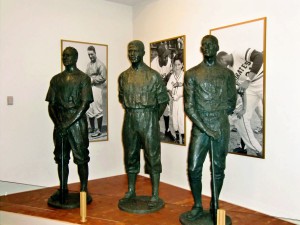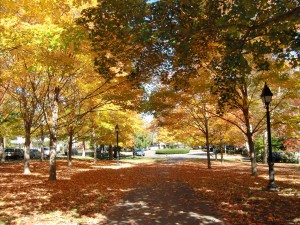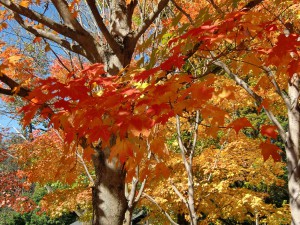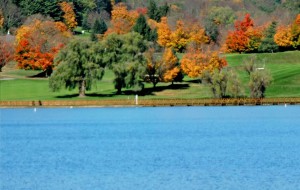EXPLORING NEW YORK – ON TO COOPERSTOWN
EXPLORING NEW YORK
This is the seventh in a series of articles about traveling the byways of New York State
ON TO COOPERSTOWN
By Charles N. Stevens
Photos by Dolores Seidman
The sun bores through the crisp morning, glistening off the damp maple leaves and sparkling off the dewdrops on the grass. Today we’re on our way to Cooperstown and the Baseball Hall of Fame, but we have miles to cover.
Outside of town, frost whitens the shady areas of grass on the local golf course. The early morning sun brings out the golds and crimsons of the maples. With the southern migration in full swing, hundreds of Canada geese mill around on a vast grassy field.
Traveling through rural countryside, we pass many dairy farms with Holstein cows grazing in their pastures. Flocks of pigeons fly around or perch on full silos, hoping for a bit to eat. Tidy horse farms with velvet-green spaces and perfectly aligned fences brighten the landscape. Fields of field corn cut with precision reminds me of a Mohawk haircut. Flashes of orange as we pass by are mounds of pumpkins for sale along the road. As if leaping from a Christmas card a white church with a tall white steeple, a weather vane on top, appears at the edge of a small village.
We skirt the town of Amsterdam founded in 1710 by Dutch settlers. Situated on the Mohawk River as part of the Erie Canal system, it was once a thriving town specializing in the manufacturing of carpets and textiles. Today those large brick buildings by the river lie idle, their tall stacks useless, windows broken and frameworks rusting. The actor Kirk Douglas was born here.
We pass over the river then parallel it as we speed down Interstate 90. Soon off the Interstate highway, and on smaller roads, we travel through more and more farmland—more rural houses, red barns and tall silos. Picturesque farms are set in green hills bordered with autumn forests, the scenes choice enough for calendar art. We zip through Cherry Valley where people have raked their fallen leaves into piles at the curb so trucks with hoses can suck them up to make mulch. Several farms raise belted cows, black with a white band around their middles. Some people call them Oreos—like dark wafers with white frosting in between. Round hay bales wrapped in white plastic lie scattered in the fields like giant marshmallows.
Finally we arrive in Cooperstown at the southern end of Lake Otsego. As baseball originated in Cooperstown, it is fitting that the Baseball Hall of Fame and Museum should be here. We enter the handsome brick building housing displays about everything any one would want to know about the game, from its origins and development to exhibits about the players and teams. Baseball memorabilia abounds. For anyone interested in baseball, this is a real Mecca. We are greeted as we enter by life-like statues of Lou Gehrig, Jackie Robinson and Roberto Clemente.
Adjacent to the museum is the Hall of Fame where the greats of baseball are honored. The hall is like a palace, a long, spacious room under an arched ceiling supported with black marble pillars. Bronze plaques along the walls show the likenesses of the Hall of Famers for every year since 1936. We see the bronze faces of several Dodgers—Sandy Koufax, Don Drysdale and Tommy Lasorda.
Cooperstown also claims a literary star, James Fenimore Cooper who wrote frontier novels about the area. His most famous book was The Last of the Mohicans, but he also wrote a series of novels called The Leather Stocking Tales with their hero Natty Bumppo. A statue of Cooper stands in a park close to the center of town. His father founded the town, naming it after himself.
Dolores and I are interested in the main street of the small town, its quaint old buildings like a picture postcard. We walk down the street in the noonday sun, eventually deciding to have lunch in a small café called the Cooperstown Diner. The space is quite narrow inside and probably looks as it did over fifty years ago. We take a seat at the counter as the tables are full, a single waitress running around in a frenzy trying to serve us all. On the counter is a large tilted jar containing do-nuts and a plastic case displaying sweet rolls, items we hadn’t seen in years. Eventually the waitress brings our grilled cheese sandwiches and potato salad.
We walk several blocks down to the shore of Lake Otsego, the way vibrant with golden and flaming maples. We kick through the brittle carpet of leaves covering the sidewalk, the scattering leaves rustling like static.
Just off a walkway following the lake’s shoreline, we find a bench where we can relax and gaze at the deep blue of the lake and the forests bordering it. A fresh breeze blows off the water, setting the moored boats bobbing in the rhythm of small waves. Seagulls cry and mallard ducks swim close to the shore. Children throw pieces of bread to them.
On the way back up town we see many more Halloween decorations on porches as well as the ubiquitous pots of chrysanthemums. A man riding on what looks like a power mower picks up a layer of fallen leaves from a lawn, leaving behind pristine grass and a cloud of dust.
Now leaving Cooperstown on our bus, we drive by the Leather Stocking Golf Course and the Fenimore Art Museum, the fame of Cooper still alive in the town.
Farther along the road are more dairies and fields of field corn ready to be cut up for feed. In the distance a tall, slender building rises dramatically out of the flat countryside, a new Indian casino. Machinery plows through acres of brittle-gray soy bean fields, harvesting the beans. We spot a mass of sticks nestled in a power transmission tower, the nest of an eagle.
Reaching the city of Auburn, we register at the Inn at Finger Lakes—without a lake in sight!

Lou Gehrig, Jackie Robinson and Roberto Clemente greet us at the Baseball Hall of Fame.

We walk through a carpet of autumn leaves in Cooperstown.

Some of the trees seem almost to flame in their fall splendor.

We relax on the shores of Lake Otsego.



